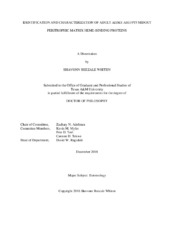| dc.description.abstract | Bloodfeeding is a high risk, high reward process that has evolved in many arthropods. The adult female Aedes aegypti mosquito- a hematophagous arthropod, is the principle vector of dengue, chikungunya, yellow fever and Zika viruses. While these viruses must transverse the midgut to be transmitted, the ingested blood meal must also be digested, absorbed, or excreted, as aggregation of blood meal metabolites (heme) potentiates a toxic environment for the female mosquito midgut. The midgut peritrophic matrix (PM), a semipermeable extracellular layer comprised of chitin fibrils, glycoproteins and proteoglycans, has been shown to facilitate heme binding, and thereby serves as a protective mechanism after blood meal feeding. However, the protein composition, and specifically heme-binding proteins, of this structure have not been characterized for adult female Ae. aegypti. Therefore, as part of this dissertation, we: 1) conducted a proteomic analysis to identify constituents of the adult female Ae. aegypti early midgut PM, 2) conducted a heme-enrichment proteomic analysis to isolate adult female Ae. aegypti midgut PM heme-binding proteins, and 3) conducted reverse genetic analyses to determine the physiological function of known and putative adult female Ae. aegypti heme-binding proteins. We identified 474 unique proteins, with 115 predicted as secreted proteins without transmembrane domains in the adult female Ae. aegypti early midgut PM. To our surprise, 10% of the peptides identified were known salivary proteins, but most interestingly, we isolated the two known and a novel PM peritrophin. As part of our midgut PM enrichment analysis, we identified 23 heme-enriched proteins, including one known heme-binding protein. Through gene expression profiling experiments, we found that one PM protein (AeAper50; AAEL002467) increased in expression by 300-fold within four hours of blood meal feeding.
However, RNAi-mediated single and multiplex knockdown experiments of this gene and two related PM proteins showed no significant phenotypic effect on mortality, fecundity or hatch rate. Likewise, we found no significant alternations in catalase or ferritin expression with loss of function for the known and putative midgut PM proteins. Taken together, these results suggest that adult female Ae. aegypti have evolved many (known and unknown) mechanisms to ensure a favorable environment and avoidance of oxidative damage after bloodfeeding. | en |


